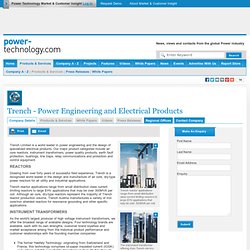

EMU Site pictures 2.jpg. EMU Site pictures 1.jpg. OPAC Title List. Thomas & Betts Asia (S) Pte Ltd Profile Information Details. Glossary and Terminology. A wheel notation (not now common) for a locomotive with two 6-wheeled bogies where the outer axles of each bogie are powered and the centre axle is unpowered or trailing.

Association of American Railroads. US body for determination of railway engineering standards, equivalent to the European UIC. Abnormal Heavy Road Load Any road load which falls outside the scope of the Construction and Use Regulations because of its weight or weight distribution.RT Acceptance In UK railway signalling terms, 'acceptance' means the permission given by a signalman for a train to enter the section of line he controls. Acceptance (of rolling stock) Final part of the process to introduce new types of rolling stock, onboard systems or infrastructure components to the railway network managed by Network Rail.UoS Accommodation Bridge A bridge connecting two areas of land which were under common ownership but separated when the railway was built.RT Active Suspension Add Value Machines Adhesion Coefficient (m) Air Bags Aspect.
Trench - Power Engineering and Electrical Products. Trench Limited is a world leader in power engineering and the design of specialized electrical products.

Our major product categories include air core reactors, instrument transformers, power quality products, earth fault protection, bushings, line traps, relay communications and protection and control equipment. Drawing from over forty years of successful field experience, Trench is a recognized world leader in the design and manufacture of air core, dry-type power reactors for all utility and industrial applications.
Trench reactor applications range from small distribution class current limiting reactors to large EHV applications that may be over 300MVA per coil. Although air core, dry-type reactors represent the majority of Trench reactor production volume, Trench Austria manufactures a variety of iron core/iron shielded reactors for resonance grounding and other specific applications. All Trench instrument transformers are manufactured to ISO9001 quality requirements. FM Sudafix Catalogue. This page contains a Flash digital edition of a book.

<div id="noscript"><p>This content requires Javascript to be enabled, and the Macromedia Flash Player (version 8 or later) to be installed. </p><p><a href=" Flash</a></p></div> Produced with Yudu - www.yudu.com. Overhead lines. Overhead lines in China Overhead lines in Denmark near Roskilde.

For aesthetic reasons the support structure is constructed from hollow Corten masts. An overhead line or overhead wire is used to transmit electrical energy to trams, trolleybuses or trains. It is known variously as: Overhead contact system (OCS)Overhead line equipment (OLE or OHLE)Overhead equipment (OHE)Overhead wiring (OHW) or overhead lines (OHL)CatenaryTrolley Wire In this article the generic term overhead line is used, as used by the International Union of Railways.[1] Overhead line is designed on the principle of one or more overhead wires (or rails, particularly in tunnels) situated over rail tracks, raised to a high electrical potential by connection to feeder stations at regular intervals.
Overview[edit] This article does not cover regenerative braking, where the traction motors act as generators to retard movement and return power to the overhead. Touch voltages. Earth potential rise. In electrical engineering, earth potential rise (EPR) also called ground potential rise (GPR) occurs when a large current flows to earth through an earth grid impedance.

The potential relative to a distant point on the Earth is highest at the point where current enters the ground, and declines with distance from the source. Ground potential rise is a concern in the design of electrical substations because the high potential may be a hazard to people or equipment. The change of voltage over distance (potential gradient) may be so high that a person could be injured due to the voltage developed between two feet, or between the ground on which the person is standing and a metal object. Any conducting object connected to the substation earth ground, such as telephone wires, rails, fences, or metallic piping, may also be energized at the ground potential in the substation.
This transferred potential is a hazard to people and equipment outside the substation. Causes[edit] Mitigation[edit] where. What Is Step and Touch Potential and Reducing Resistance To Ground? Step Potential Step potential is the step voltage between the feet of a person standing near an energized grounded object.

It is equal to the difference in voltage, given by the voltage distribution curve, between two points at different distances from the electrode. A person could be at risk of injury during a fault simply by standing near the grounding point.